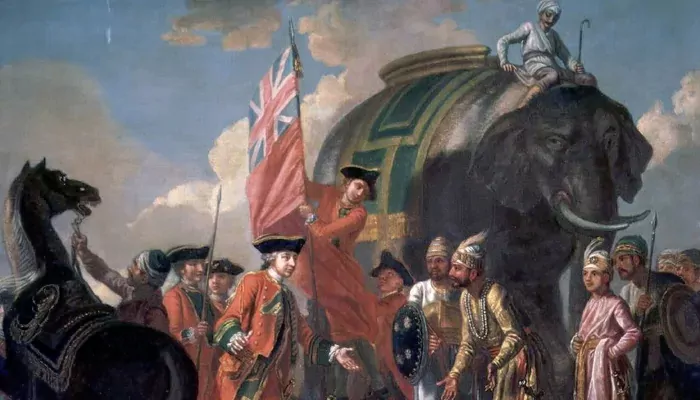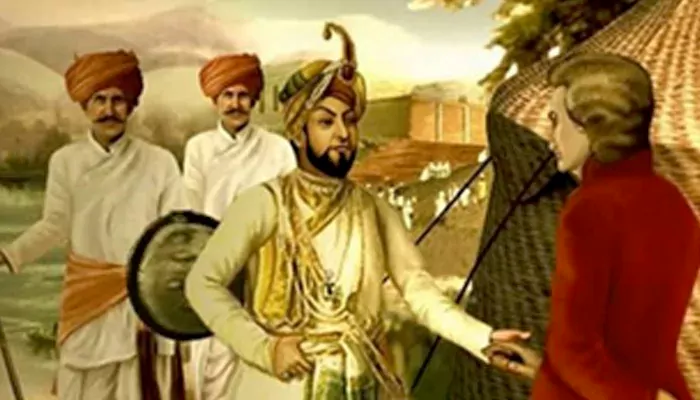
Can someone get Raj Shamani to host a podcast with Mir Jafar’s ghost?
We’ve all grown up reading history from a certain perspective. And when that perspective is repeated over and over, it becomes the only lens through which we view the past. We rarely pause to question, dig deeper, or explore the grey areas. For instance, our school textbooks taught us that Mir Jafar betrayed Nawab Sirajuddaula and sided with the British in the Battle of Plassey, ushering in nearly two centuries of colonial rule. That part is true, and there's no denying that. But before stamping him as the ultimate traitor in Indian history, do we ever stop and ask: Why did he do it? What exactly made him take that extreme step? Was it greed, fear, helplessness, or a mix of all three? And was he fully aware of the long-term consequences? Well, history rarely allows its so-called villains a chance to speak. Unfortunately for Mir Jafar, there was no podcast or Raj Shamani back then to help him tell his side of the story.
Mir Jafar Was The Commander of Siraj ud-Daulah′s Army .
— indianhistorypics (@IndiaHistorypic) May 11, 2023
In 1757 He Betrayed Siraj ud-Daulah In Battle of Plassey and Supported British Forces Led by Lord Clive pic.twitter.com/wWyOwUncMp
(Credit: indianhistorypics) )
So let’s try to understand him. Just keep in mind that I'm not here to justify or whitewash him, and certainly not to glorify. I don’t know him (obviously) or anyone from his bloodline personally. But I do believe we owe it to ourselves to look at the full picture. Because understanding the past means looking beyond the headlines and into the heart of the moment.
The mid-18th century was not really kind to Bengal. The Mughal Empire was falling apart, and regional rulers were basically running their own fiefdoms. The British, French, and Dutch were building armies to take over the region. Inside Bengal, the Nawab’s court at Murshidabad was a bubbling pot of jealousy and mistrust.
When Siraj-ud-Daulah, just 23 years old, became Nawab in 1756, he stepped into a court already bristling with resentment. The powerful banking family of the Jagat Seths, nobles like Rai Durlabh, and even European traders were sizing him up... and not with much optimism.
Among those sidelined early on was Mir Jafar, a veteran military man and relative of Siraj. Once trusted, he was pushed aside as the young Nawab filled key posts with his own loyalists. Historian Rajat Kanta Ray points out in 'From Plassey to Partition' that the conspiracy that would lead to the Battle of Plassey wasn’t born out of love for the British; rather, it was born out of a court full of men who felt threatened, or outright betrayed.
Today, Siraj is often remembered as a martyr because he was Bengal's last independent Nawab who stood up to the British. But historical records (not those from WhatsApp University) tell a more complicated story.
Contemporary writer Ghulam Husayn Khan didn’t mince words. He called Siraj "erratic, temperamental, and unpopular" among both the elite and the masses. His decisions often seemed impulsive. He seized wealth from his aunt Ghasiti Begum, executed political rivals, and alienated influential courtiers by replacing them with less experienced allies.
His economic policies didn’t help either. Powerful merchants and bankers, including the Jagat Seths, feared he would destroy their profits. His attack on the British settlement in Calcutta in 1756, which led to the infamous (and still debated) “Black Hole” incident, only cemented their opposition. Whether or not 123 people actually died that night is still a matter of dispute among historians, but the event gave the British all the justification they needed to strike back.
Historians blame Mir Jaffer for taking help of EIC to dethrone Sirajuddaula. One should never forget that Siraj himself was a BAD ruler that people wanted to get rid off him badly.
— Indian Art (@IndiaArtHistory) May 18, 2024
'Clive receiving money from Mir Jaffer for disabled soldiers.' by Edward Penny, 1772. pic.twitter.com/Ew8JvLgyV6
(Credit: Indian Art)
By the time the British came knocking, many in Bengal’s power circles (including Mir Jafar) were ready to open the door.
The Battle of Plassey is often seen as the moment the British seized India. But it wasn’t won with brute force, but over secret meetings and signed promises.
Robert Clive had just 3,000 soldiers. Siraj, on the other hand, had 50,000. Yet Clive knew the Nawab’s army was deeply divided. He sent emissaries, forged secret deals, and played on the ambitions of people like Mir Jafar, who had been promised the throne in exchange for non-intervention.
A secret treaty sealed the pact. Mir Jafar would become Nawab, and in return, the East India Company would receive massive payouts: money for the Company, for the merchants of Calcutta, and Clive himself. Clive even kept Mir Jafar guessing till the last moment, just to make sure he wouldn’t back out.
1757 :: Cannon Ball Used In Battle of Plassey
— indianhistorypics (@IndiaHistorypic) March 5, 2023
( Photo - @NAM_London ) pic.twitter.com/v7ADNP5MFw
(Credit: indianhistorypics) )
When the day of battle arrived in June 1757, a sudden downpour soaked Siraj’s gunpowder, leaving his artillery useless. Mir Jafar, commanding a large part of the Nawab’s forces, held back as planned. Siraj’s army crumbled, and the British claimed victory.
There’s no denying that Mir Jafar betrayed Siraj. His refusal to fight sealed the young Nawab’s fate. After the battle, Siraj fled, was captured, and eventually killed, reportedly on the orders of Mir Jafar’s son, Miran.
But to call Mir Jafar a traitor to India is historically off the mark. India, as a unified nation, didn’t exist in 1757. What existed were regions, kingdoms, and princely states, each with its priorities. Mir Jafar’s move, in his eyes, might have been about stability or self-preservation.
What he didn’t see coming was how thoroughly the British would tighten their grip. Once he was installed as Nawab, they began draining Bengal’s wealth through trade privileges and forced payments. The treasury, far from overflowing, was running dry. Within three years, they replaced him with Mir Qasim, his son-in-law. Mir Jafar got a second term briefly, but died in 1765, disgraced and sidelined.
As Arup K. Chatterjee of OP Jindal Global University puts it, “If I were to apply the logic of per capita accountability, Mir Jafar would not appear to have had the strongest agency.” In other words, the real puppet masters might have been the bankers, merchants, and political players around him, not the man himself.

Notably, while there’s no historical evidence to support it, myth suggests that after Siraj ud-Daulah’s death, his corpse was tied to a donkey’s back and dragged through the streets of Plassey as a final act of humiliation. Folklore also recounts that many locals, especially women, watched without sorrow, some even with relief. For them, his death marked the end of what they saw as a reign of cruelty and unchecked brutality. Stories from that time speak of women lighting lamps in celebration of the tyrant’s fall.
What happened next was as much about storytelling as it was about history. During India’s independence movement, nationalist leaders turned Mir Jafar into the villain of colonialism, who opened the door to British rule. Meanwhile, Siraj was recast as the tragic hero.
Walk through the remnants of Jaffarganj Palace, and you’ll find the “Namak Harami Deori”, the Gate of the Traitor. In political speeches, “Mir Jafar” became a label to stick on anyone seen as a sellout. And in public memory, his name became heavier than the facts behind it.
Not everyone agrees with this version. In 2017, Syed Mohammad Abbas Ali Meerza, a descendant of Mir Jafar, told The Hindu that his ancestor was being unfairly blamed. “He wasn’t the only one,” he said, adding, “There were others who plotted, financed, and benefited. But history only remembers him.”
Let’s stretch our imagination. It’s 2025. Mir Jafar is on a podcast, sitting across from a curious host. The question comes: “Why did you betray Siraj?”
He sighs. “I didn’t trust him,” he says. “None of us did. The court was falling apart. The merchants were scared. And the British promised order. I didn’t think I was selling Bengal. I thought I was saving it.”
Then he might add, “You think I wanted to be remembered as a traitor? I made a call. And yeah, I got played. We all did.”
Mir Jafar’s story is of a man who made a deal... and lost. He gambled on the British, thinking they would help him fix a broken system. Instead, they turned him into a pawn in their empire-building game. As historian Rudrangshu Mukherjee points out, both Siraj and Mir Jafar were shaped by their circumstances. Neither fully grasped the scale of what was coming.